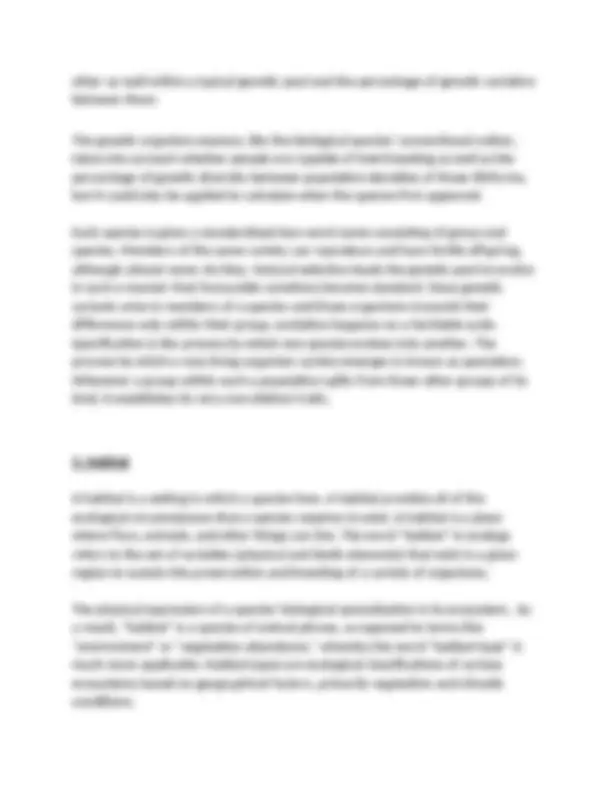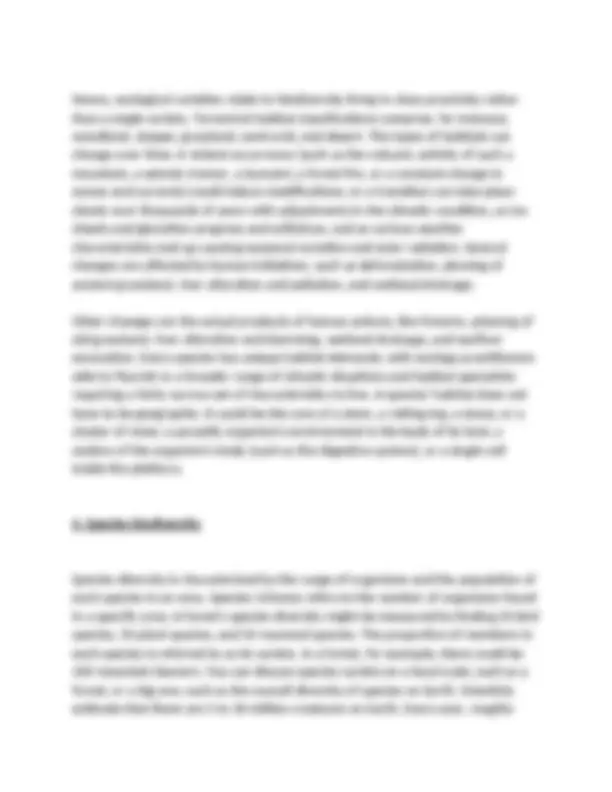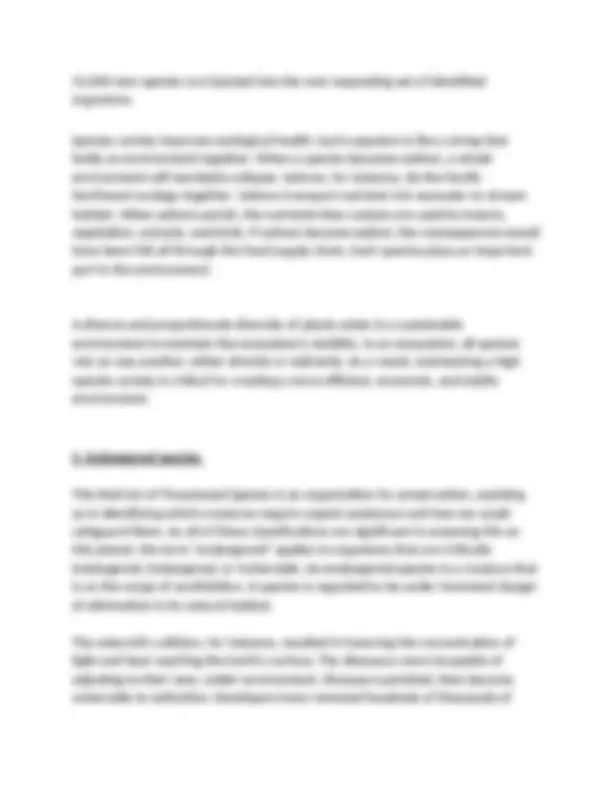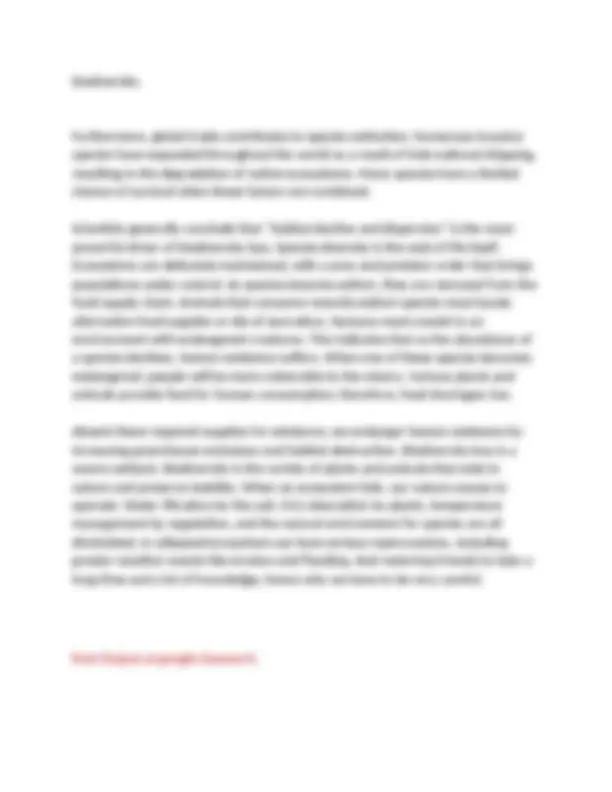









Study with the several resources on Docsity

Earn points by helping other students or get them with a premium plan


Prepare for your exams
Study with the several resources on Docsity

Earn points to download
Earn points by helping other students or get them with a premium plan
Community
Ask the community for help and clear up your study doubts
Discover the best universities in your country according to Docsity users
Free resources
Download our free guides on studying techniques, anxiety management strategies, and thesis advice from Docsity tutors
The concept of biodiversity, its significance for ecological and economic factors, and the major threats leading to its loss. the importance of biodiversity as a source of food, cosmetics, and medications, and the challenges in quantifying it due to its complexity. The document also introduces the concepts of ecological and genetic species, and the impact of habitat destruction, overexploitation, and introduction of foreign organisms on biodiversity.
Typology: Assignments
1 / 13

This page cannot be seen from the preview
Don't miss anything!








Written Activity 2 Name: Joan Nicole P. Bongcawel Date: 6-17- Class Period: 4:30 pm- 6:30 pm Section: III- Compassion Term 2 A. Explain the following based on your understanding: Source: STAS book pp 126 - 1.Biodiversity The variation of living things is referred to as "biodiversity." Biodiversity draws together various species and lifeforms, as well as their diversity, or even the processes of development in their habitats. Life could not exist absent biodiversity. In 1985, the term "biodiversity" was established. It is essential in both native and manufactured settings. It is concerned with nature's diversity, the biosphere. It refers to differences between vegetative, animal, and microbial species. The quantity of various creatures and their corresponding populations in an ecosystem are all part of biodiversity. It also depicts the organizational structure of life at various levels. Biodiversity is important for both ecological and economic factors. Biodiversity is a potential repository for the production of foodstuffs, cosmetics, and medications. Agriculture, animals, fishing, and the woods all provide plentiful food sources. Species of plants produce wood, fibers, fragrances, lubricants, rubber, resins, toxins, and cork. No aspect of Earth is much more intricate, active, or diverse than that of the components of the living species that inhabit its lands and bodies of water, and no feature is undergoing more drastic transformation at the hands of people than this astonishing, singularly unique characteristic of Earth. Clean air, water facilities, rich soil, profitable lands, plentiful seas, and the planet's recent egalitarian climate, as well as other natural ecosystems, are indications of life's functioning. Because the complexity of biodiversity makes quantification difficult, a myriad of alternative or alternative metrics are
frequently used. This includes the range of unique genetic variants in a soil specimen of microbial DNA, the species diversity of particular taxa, and the variety of unique plant structural forms. Measures of biodiversity focused on organisms or other taxa, on the other hand, typically capture crucial properties such as variations, functionality, number, and dissemination, which offer perspective into the responsibilities of biodiversity. Simply put, biodiversity pertains to the variability of lifeforms in our world.
2. Species On Earth, there are quite a limited number of different types of biological things. Creatures can also be defined by their karyotype, DNA composition, appearance, behavioral patterns, or environmental habitat. Individuals of the same species can mate and have viable children, but practically never with individuals of other species. Separate species have been known to generate hybrid offspring, but among Galapagos finches, the offspring are virtually always adaptive radiation. Interbreeding exclusively amongst organisms is significant for development because members of one group share a similar genetic pool that those of other animals do not. There will always be some diversity among individuals together within a shared pool, and those whose genetic differences put them in a vulnerable position in a specific ecosystem are likely to be discarded in favor of those with favorable variation. The gene pool evolves as a byproduct of this natural selection mechanism. Furthermore, because fossil development cannot be studied, paleontologists employ the idea of chronospecies. In biology, species categorization includes associated creatures that have common features and are susceptible to reproduction. The idea of biological organisms is commonly utilized in biology and related subjects of research. The environmental species aspect, which characterizes an organism as a cluster of living things defined by the resources around which they depend heavily; and the genetic lifeforms idea, that either perceives all living things proficient of genes inherited traits from each
Hence, ecological varieties relate to biodiversity living in close proximity rather than a single variety. Terrestrial habitat classifications comprise, for instance, woodland, steppe, grassland, semi-arid, and desert. The types of habitats can change over time. A violent occurrence (such as the volcanic activity of such a mountain, a seismic tremor, a tsunami, a forest fire, or a constant change in waves and currents) could induce modifications; or a transition can take place slowly over thousands of years with adjustments in the climatic condition, as ice sheets and glaciation progress and withdraw, and as various weather characteristics end up causing seasonal variation and solar radiation. Several changes are affected by human initiatives, such as deforestation, plowing of ancient grassland, river alteration and pollution, and wetland drainage. Other changes are the actual products of human actions, like forestry, plowing of old grassland, river alteration and damming, wetland drainage, and seafloor excavation. Every species has unique habitat demands, with ecology practitioners able to flourish in a broader range of climatic situations and habitat specialists requiring a fairly narrow set of characteristics to live. A species' habitat does not have to be geographic; it could be the core of a stem, a rotting log, a stone, or a cluster of moss; a parasitic organism's environment is the body of its host, a section of the organism's body (such as the digestive system), or a single cell inside the plethora.
4. Species biodiversity Species diversity is characterized by the range of organisms and the population of each species in an area. Species richness refers to the number of organisms found in a specific area. A forest's species diversity might be measured by finding 20 bird species, 50 plant species, and 10 mammal species. The proportion of members in each species is referred to as its variety. In a forest, for example, there could be 100 mountain beavers. You can discuss species variety on a local scale, such as a forest, or a big one, such as the overall diversity of species on Earth. Scientists estimate that there are 5 to 30 million creatures on Earth. Every year, roughly
13,000 new species are injected into the ever-expanding set of identified organisms. Species variety improves ecological health. Each organism is like a string that holds an environment together. When a species becomes extinct, a whole environment will inevitably collapse. Salmon, for instance, tie the Pacific Northwest ecology together. Salmon transport nutrient-rich seawater to stream habitat. When salmon perish, the nutrients they contain are used by insects, vegetation, animals, and birds. If salmon became extinct, the consequences would have been felt all through the food supply chain. Each species plays an important part in the environment. A diverse and proportionate diversity of plants exists in a sustainable environment to maintain the ecosystem's stability. In an ecosystem, all species rely on one another, either directly or indirectly. As a result, maintaining a high species variety is critical for creating a more efficient, economic, and stable environment.
5. Endangered species This Red List of Threatened Species is an organization for preservation, assisting us in identifying which creatures require urgent assistance and how we could safeguard them. As all of these classifications are significant in assessing life on this planet, the term "endangered" applies to organisms that are Critically Endangered, Endangered, or Vulnerable. An endangered species is a creature that is on the verge of annihilation. A species is regarded to be under imminent danger of elimination in its natural habitat. The asteroid's collision, for instance, resulted in lowering the concentration of light and heat reaching the Earth's surface. The dinosaurs were incapable of adjusting to their new, colder environment. Dinosaurs perished, then became vulnerable to extinction. Developers have removed hundreds of thousands of
rehabilitation, are being directed towards several vulnerable species. Captive breeding procedures, on the other hand, are typically hard to incorporate for highly mobile animals such as migratory birds and fish. While poaching significantly affects endangered animal species, lawful, for-profit private agriculture has the inverse effect. It has significantly increased the numbers of southern black rhinoceros and southern white rhinoceros. Nonetheless, a species' preservation state implies the risk that it will become endangered. When determining the state of a species, many aspects are taken into account, including data such as the number of individuals left, the general rise or decline in demographics over time, breeding success rates, and recognized risks.
6. Threats to Biodiversity Humans need commodities to live and flourish, and that those things are now being extracted from our ecosystem in an unsustainable manner. The three most immediate risks to biodiversity are habitat destruction, overexploitation, and the introduction of foreign organisms. The first two are a direct effect of the global population's rise and environmental consumption. Global climate change is partly a result of the population's increasing energy demands and the usage of fossil fuels to satisfy such demands. Toxic contamination, for example, has distinct impacts on species but is not widely regarded as a hazard of the same scale as the others. Habitat dispersion is exacerbated by ecosystem transition and deterioration. The most prominent causes of the loss of habitat are resource extraction, agriculture conversions, and development. The most significant contributor to biodiversity loss is habitat loss due to resource exploitation, agricultural conversion, and urbanization. As a result of habitat fragmentation, smaller isolated areas of territory will not be able to sustain species communities in the coming years. Contamination of the
atmosphere and waterways has far-reaching detrimental consequences for biodiversity. Highly contaminated streams cause the departure of traditional reproductive grounds, resulting in the extinction of salmon species. Pollution vulnerability varies by organism. Several species, however, are sensitive to the indirect impacts, such as harmful chemical concentrations in large predators of food chains and modifications of predator-prey relationships. Preserving landscape connectivity may mitigate its adverse effect on biodiversity. According to the barrier principle, refuges linked by lanes will have greater immigrant percentages than secluded areas of pristine habitat. Habitat portions linked by corridors must always be big enough to sustain diverse populations, particularly for big vertebrates. Many corridor design characteristics influence the success of wildlife habitats, including habitat type and structural stage, length and width, and the intensity of anthropogenic activities in and around the route. Various connection scales are required by distinct species. Some species may scatter in relatively thin natural vegetative segments, such as hedgerows, whilst others require substantial ecological portions close together with very low migrating times over inadequate environments. Global warming as well as climate change are already having catastrophic effects on biodiversity. At just the moment, the process of wiping out habitats for agricultural transition and industrial growth is displacing creatures from their native homes. Other than the first of the five stated risks, there are other other factors which may perhaps subsequently lead to biodiversity loss. This phenomenon has an impact not just on wildlife as well as on people's wellbeing. The convergence of global population expansion and resource usage is the primary risk to biodiversity in the world today, and thus a hazard to human wellbeing.
7. Biodiversity Hot spots Only 2.4 percent of the earth's natural surface is covered by biodiversity hotspots, which support different habitats. Other places at risk include the Tropical Andes,
There are ten vulnerable endemic bird species and over 4,400 indigenous plant species here. The larger mammals, such as the huge armadillo, jaguar, and giant anteater, are among the distinctive species found here. The Philippine hotspot is one of the world's most biodiverse places. With such widespread distribution, the hotspot is home to 6,000 endemic species and an uncountable variety of bird species, such as the Philippine eagle and the Cebu flowerpecker. Numerous international institutions are collaborating to protect biodiversity hotspots. As we have observed, a biodiverse environment is one with a great range of organisms. There are 36 biodiversity hotspots in our world, and they are stunning, one-of-a- kind, and teeming with life. Several biodiversity hotspots are presently under threat of extinction. Human- induced habitat damage, along with harm induced by climate change, are the major drivers of the annihilation of the planet's species. As a result, people would've been extinct without biodiversity, since biodiversity hotspots are critical for our lives. Biodiversity hotspots are among the most important and diverse ecosystems on the planet since they are home to innumerable fragile human groups who depend on nature for survival. B. Watch a 2-minute video presentation on "What is Biodiversity?" using this link https://youtu.be/b6Ua_zWDH6U After watching the video, write a half-page reflection using these guide questions: a. Do you think abundant Biodiversity is essential? b. What example can you provide of how particular geographic features of organisms benefit humans? c. What human activities can lead to biodiversity loss and destruction? List the
identified actions. d. Do you think the extinction of species is a sign of alarm about the planet's health? The significance of Biodiversity Biodiversity refers to the immense range of existence on Earth. It covers all organisms, including plants, animal life, and humans. We are woven into the web of existence. It provides us with food, medication, and a home. It is critical to the long-term viability of an ecosystem. The greater the number of species in an environment, the greater the variety. A species-diverse ecosystem is more adaptable to ecological change and human implications. Tropical rainforests, which contain almost half of the world's biodiversity, are more likely to resist and recover from catastrophic events such as fires and floods than less diverse ecosystems. Biodiversity supplies a wide range of basic commodities on which we all rely. It contributes to a steady climate. It supplies food, freshwater, natural resources, and recreational opportunities. Our planet's diverse, robust ecosystems may appear to be indestructible, yet they are in fact highly susceptible to fall. Humans rely on ecological systems such as freshwater resources, pollination, soil quality and security, food, and medication, whether they live in a village in the Amazon or a metropolis like Beijing. Ecosystems degraded by biodiversity loss are less likely to provide essential benefits, particularly due to the demands of an ever-increasing world population. Overfishing, seasonal drought, altering rainfall patterns, and water diversions by upstream developments are all putting strain on the reservoir, resulting in biodiversity destruction, lower fishing returns, and a diminished ability to sustain humanity. Absent management measures in a particular area, it could potentially be the downfall of several species. Basically, biodiversity is fundamental because humanity depends on a good environment to thrive. This is particularly true in the
biodiversity. Furthermore, global trade contributes to species extinction. Numerous invasive species have expanded throughout the world as a result of international shipping, resulting in the degradation of native ecosystems. Many species have a limited chance of survival when these factors are combined. Scientists generally conclude that "habitat decline and dispersion" is the most powerful driver of biodiversity loss. Species diversity is the web of life itself. Ecosystems are delicately maintained, with a prey and predator order that brings populations under control. As species become extinct, they are removed from the food supply chain. Animals that consume recently extinct species must locate alternative food supplies or die of starvation. Humans must coexist in an environment with endangered creatures. This indicates that as the abundance of a species declines, human existence suffers. When one of these species becomes endangered, people will be more vulnerable to the misery. Various plants and animals provide food for human consumption; therefore, food shortages rise. Absent these required supplies for existence, we endanger human existence by increasing greenhouse emissions and habitat destruction. Biodiversity loss is a severe setback. Biodiversity is the variety of plants and animals that exist in nature and preserve stability. When an ecosystem fails, our nature ceases to operate. Water filtration by the soil, CO2 absorption by plants, temperature management by vegetation, and the natural environment for species are all diminished. A collapsed ecosystem can have serious repercussions, including greater weather events like erosion and flooding. And restoring it tends to take a long time and a lot of knowledge, hence why we have to be very careful. Post Output at google classwork.